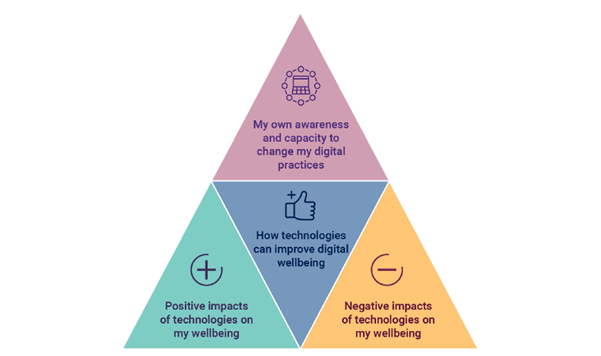New Voices RGU Student Series – Laura Gormley
Category: New Voices, New Voices, RGU Student Series
In the Robert Gordon University Student Series blog, we share the views of RGU students from the MSc in Information and Library Studies course.
Today, we hear from Dr Laura Gormley on the pivotal importance of digital wellbeing and what she thinks libraries can do to embed it within their services. Laura is studying for her MSc in Information and Library Studies at Robert Gordon University and currently works as a supply library assistant for Stirling Council Libraries.
Digital Wellbeing in the post-COVID context
Many aspects of daily life such as work and education have been driven online by the COVID-19 pandemic, and therefore it has never been more important to pay attention to digital wellbeing, a crucial component of digital literacy.
Digital wellbeing is defined by JISC as the “impact of technologies and digital services on people’s mental, physical and emotional health” (JISC. 2019). Research into the consequences of unfettered and uncritical digital engagement on the user is now being conducted (for example, with unregulated smartphone use, cf. Lukoff, Yu et al. 2018 and the interplay between the “fear of missing out” or “FoMO” (social anxiety brought on by the discovery, normally via social media, of a desirable event at which one is not present), social media and task disruption, cf. Rozgonjuk, Sindermann et al.. 2020). There is a realisation that, however positive the benefits of digital literacy and engagement, a failure to understand potential negative effects could have implications for health and wellbeing (Cecchinato, Rooksby et al.. 2019). JISC’s digital wellbeing model neatly encapsulates this notion of balance with its crucial element of awareness placed at the top of the triangle:
Students are now even more engaged digitally for longer periods of time because of COVID-19, since much of delivery has switched to online (88.5% of UK universities will deliver blended learning for session 2020/21, StudentCrowd. 2020). Because of this increase in time spent online, it can be argued that three potentially negative effects with the greatest impact might be: digital overload, too much screentime and distraction issues. In truth, increasing time spent online can exacerbate any of the negative effects outlined by JISC, such as unfavourable comparisons with others and cyberbullying (JISC. 2019); however, focusing on awareness and time management when using digital technologies will likely have a positive overall effect on other online behaviours.
In order to help students overcome these potentially negative effects, many universities have a dedicated digital wellbeing section of the websites which details good advice and best practice (such as Staffordshire University. 2020 and the University of Queensland. 2020), and often this section falls under the domain of the institutions’ libraries. Since social media is usually the biggest culprit in terms of digital distraction, some of these dedicated spaces (e.g. that of Wolfson College, Cambridge. 2020; and Sheffield Hallam University. 2020) advocate the use of apps such as Checky (2020) which calculates how often users look at their device, and OFFTIME (2020) which locks certain functions on a smartphone to enable users to work without interruption. Excellent resources such as these need frequent signposting in order to embed good digital practice, otherwise one has to rely on a student’s own awareness of the need to actively seek information on digital wellbeing.
Therefore, it can be argued that information professionals working at FE and HE institutions have a key role in growing student awareness of the need for digital wellbeing through signposting. Perhaps library websites could have pop-ups with little hits of advice, or hints and tips delivered by a subscription email, or learning technologists developing e.g. timers on Moodle to help students chunk their work to avoid overload. But would that be enough?
Engendering lasting cultural change needs a greater depth of engagement. Information professionals need to embody practices of digital wellbeing – to ‘walk the talk’. This would require well-designed, up-to-date continuous professional development for information professionals in this area (cf. JISC’s Briefing for Senior Leaders. 2019), and then modelling best practice for others. This is obviously harder whilst many employees in the sector are still working from home, but there are things that can be done, such as calling for a break in a lengthy cross-department Teams meeting, or perhaps demonstrating good ergonomics whilst advising students online (and performing a few tension-release exercises, too?), or managing schedules so as to be signed out for lunch and taking a walk, instead of being visibly “available” and “online” all day. As information professionals we have so many emerging roles (Vassilakaki and Moniarou-Papaconstantinou. 2015); there is a strong case that digital wellbeing role model be one of them.

